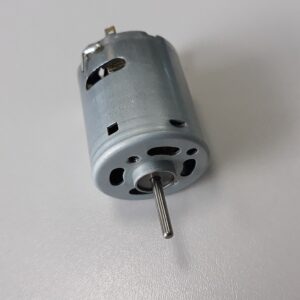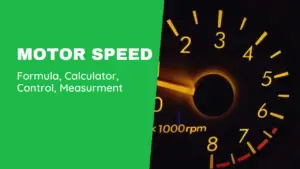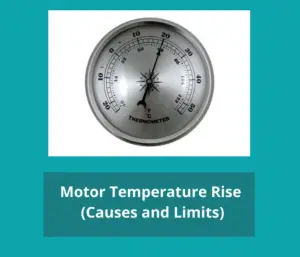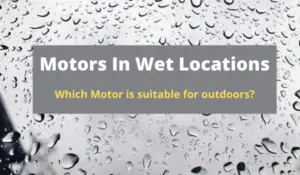Table of Contents
ODP vs TEFC Motor Table
Here’s a comparison of TEFC (Totally Enclosed Fan-Cooled) and ODP (Open Drip-Proof) motors in table format (ODP vs TEFC):
| Feature | TEFC Motors | ODP Motors |
|---|---|---|
| Enclosure Design | Totally enclosed and sealed | Open to the environment |
| Environmental Protection | Suitable for indoor and outdoor use; provides protection against dust, dirt, moisture, and corrosive gases | Primarily for indoor use or clean environments; designed to prevent liquid drips onto windings |
| Cooling Mechanism | Internal fan for efficient cooling | Relies on natural convection; less efficient cooling |
| Common Applications | Outdoor equipment, industrial machinery, environments with exposure to contaminants | Indoor applications with minimal exposure to contaminants |
| Efficiency | Often higher cooling efficiency, potentially leading to better motor efficiency | May have slightly lower cooling efficiency due to the lack of an internal fan |
| Example Use Cases | – HVAC systems | – Some types of HVAC systems |
| – Industrial machinery | – Indoor machinery | |
| – Outdoor equipment | ||
| – Environments with dust, dirt, moisture, and corrosive gases |
This table summarizes ODP vs TEFC motors, including their enclosure design, environmental protection, cooling mechanisms, typical applications, and efficiency considerations.
The choice between these motor types should be based on the specific needs of your application and the operating environment.
What Does ODP Motor Stand for?
ODP motor stands for Open Drip-Proof motor. It is a type of electric motor with a specific design to allow airflow for cooling while providing limited protection against moisture and debris.
-
Applications:
- Commonly used in industrial or commercial settings where the environment is controlled.
- Examples include pumps, compressors, and HVAC systems.
-
Limitations:
- ODP motors Not suitable for outdoor use or environments with excessive dust, dirt, or moisture.
- For harsher conditions, TEFC (Totally Enclosed Fan-cooled) motors or other enclosed designs are preferred.

In ODP motors the protection against dust and humidity is poor, So the dust and humidity can directly enter the motor, making a kind of dirty winding and bearing.
Some motor manufacturers make laminated winding and sealed bearings to overcome dust and airborne contaminants issues.
Can I use ODP outdoors?
Using an ODP (Open Drip-Proof) motor outdoors is generally not recommended because its design provides limited protection against environmental factors like rain, dust, dirt, and high humidity. However, in some specific cases, it might be feasible with additional protective measures.
Why ODP Motors Aren’t Ideal for Outdoor Use:
- Limited Protection:
- ODP motors are designed to protect against vertically falling water droplets but not against horizontal rain, snow, or heavy wind-driven moisture.
- Exposure to Contaminants:
- Dust, dirt, and debris can easily enter through the open frame, potentially damaging the motor’s internal components.
- Corrosion Risk:
- Humidity and exposure to the elements can cause corrosion, leading to a shorter lifespan for the motor.
Exceptions:
You might be able to use an ODP motor outdoors if you take adequate precautions, such as:
- Protective Enclosure: Install the motor inside a weatherproof enclosure or under a shelter that allows airflow but keeps out rain, snow, and debris.
- Proper Elevation: Mount the motor above ground level to protect it from water pooling or splashing.
- Environmental Controls: Ensure the location is in a relatively clean and dry environment with minimal risk of direct exposure to the elements.
Alternative Solution:
For outdoor applications, it’s better to use a Totally Enclosed Fan-Cooled (TEFC) motor or a Weather-Protected Type I or II (WPI/WPII) motor. These designs are more robust for outdoor and harsh conditions.
I have written a detailed article about motor burnout reasons, you can find it here.
Can Open Drip-proof (ODP) motors be used in industrial areas?
Yes, Open Drip-Proof (ODP) motors can be used in industrial areas, but their suitability depends on the specific environmental conditions of the site.
ODP motors are typically designed for indoor use or relatively clean and dry environments. Here’s a breakdown of their suitability in industrial settings:
Where ODP Motors Can Be Used in Industrial Areas:
-
Clean, Indoor Environments:
- ODP motors are ideal for locations where there is minimal dust, debris, or moisture, such as:
- HVAC systems
- Pumping stations
- Machinery inside clean manufacturing facilities
- ODP motors are ideal for locations where there is minimal dust, debris, or moisture, such as:
-
Controlled Environments:
- Industrial areas with proper ventilation, low humidity, and no direct exposure to contaminants may use ODP motors effectively.
-
Low Risk of Splash or Spray:
- As the name suggests, ODP motors are protected against water droplets falling vertically, so they can be used where liquid exposure is minimal.
Where ODP Motors Should NOT Be Used:
-
Dusty Environments:
- Industrial sites with high levels of dust (e.g., sawmills, cement plants, or grain processing facilities) can cause dust to enter the motor, leading to overheating and damage.
-
Humid or Wet Areas:
- Locations with high humidity, water splashes, or exposure to rain and chemicals can corrode the motor and cause electrical failures.
-
Explosive Atmospheres:
- Hazardous environments where flammable gases, vapors, or dusts are present require motors with explosion-proof or sealed designs, like TEFC or explosion-proof motors.
You can read my detailed article about, Electric motors temperature rise, causes and solutions.
What does TEFC motor mean?
A TEFC motor stands for Totally Enclosed Fan-Cooled motor. It is a common type of electric motor with a robust enclosure and integrated cooling mechanism designed for use in a wide range of environments, including harsh and industrial conditions.
Key Features of TEFC Motors:
-
Totally Enclosed:
- The motor’s enclosure prevents external contaminants like dust, dirt, water, or chemicals from entering and damaging internal components.
- While it is “totally enclosed,” it is not entirely airtight but is sealed to block most contaminants.
-
Fan-Cooled:
- A fan mounted on the shaft, external to the motor housing, provides cooling by directing air over the outer surface of the motor.
- This allows efficient heat dissipation without requiring open ventilation.
-
Durable Construction:
- The motor is built to withstand tough conditions, making it suitable for outdoor use and environments with moderate exposure to weather, dust, or moisture.
Typical Applications:
- Industrial equipment like pumps, compressors, and blowers.
- Outdoor installations, including agriculture and construction equipment.
- Environments with moderate exposure to weather and contaminants.
Can TEFC motors be used in hazardous locations?
TEFC (Totally Enclosed Fan-Cooled) motors are generally not designed for hazardous locations unless they are specifically rated and certified for such environments. Hazardous locations are areas where flammable gases, vapors, or dusts are present and could ignite under certain conditions.
Motors for these environments must meet stringent safety standards to prevent sparks, overheating, or other conditions that could cause ignition.
Why Standard TEFC Motors Are Not Suitable for Hazardous Locations:
-
No Explosion-Proof Rating:
- Standard TEFC motors are not built to contain an internal explosion or prevent sparks from escaping.
-
Potential for Overheating:
- If the motor overheats or malfunctions, it could ignite flammable materials in the environment.
-
Lack of Sealing Against Hazardous Materials:
- TEFC motors are sealed against contaminants like dust and moisture, but not against gases or explosive atmospheres.
When TEFC Motors Can Be Used in Hazardous Locations:
A TEFC motor can be used in hazardous locations only if it is specifically designed, rated, and certified for the hazard classification of the area. Certifications to look for include:
- Explosion-Proof (XP) or Flameproof (Ex d): Designed to contain and prevent explosions.
- Hazardous Location Ratings: Defined by standards such as:
- NFPA 70 (NEC): Class, Division, and Group ratings for the US.
- IECEx or ATEX: International standards.
Which motor type is better ODP or TEFC?
The choice between ODP (Open Drip-Proof) and TEFC (Totally Enclosed Fan-Cooled) motors depends on the application, operating environment, and specific requirements. Neither is inherently “better” in all situations, but each has its strengths and limitations.
-
Choose an ODP Motor if:
- The environment is clean and dry (e.g., indoor facilities).
- Cost is a primary concern.
- Easy access for regular maintenance is available.
-
Choose a TEFC Motor if:
- The environment is harsh, with exposure to dust, dirt, or moisture.
- Durability and low maintenance are priorities.
- Outdoor or industrial use is required.
- You need a motor for hazardous areas (with proper certification).
In summary, there is no one-size-fits-all answer to whether ODP or TEFC motors are better. The choice should be based on the specific needs of the application and the environmental conditions in which the motor will operate.
For more details about motor insulation class read my other article here.
Don’t Leave Empty-Handed!
Install my Free Android App on Google Play:
Electrical Cables Most Common Tables “Cables Tables”
And, my Electrical Calculations App “Fast Electrical Calculator”
Discover more great content by subscribing to My channel
Looking to stay ahead of the game in the world of electrical engineering? Subscribe to my YouTube channel and gain access to exclusive content you won’t find anywhere else!
The staff I recommend
(Amazon Affiliate Links to products I believe are high quality):
- Economy 120 Volt/60Hz AC Power Source – Step-Down Voltage & Frequency Converters 1800W
- UNI-T Digital Multimeter Tester UT139C
- 50-Amp Extension Cord for RV “100ft”
- Voltage Stabilizer 110/220v
- Hair Dryer “best selling“
- TOSHIBA EM131A5C-BS Countertop Microwave Ovens
Disclaimer: This contains affiliate links to Amazon products. I may earn a commission for purchases made through these links.




